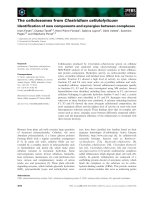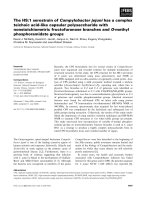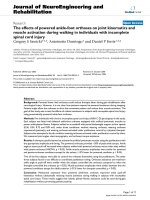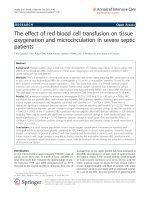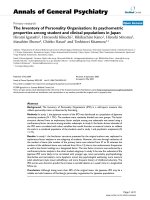Báo cáo y học: "The propofol infusion syndrome: more puzzling evidence on a complex and poorly characterized disorder" ppt
Bạn đang xem bản rút gọn của tài liệu. Xem và tải ngay bản đầy đủ của tài liệu tại đây (45.57 KB, 2 trang )
Available online />Page 1 of 2
(page number not for citation purposes)
Abstract
The propofol infusion syndrome is a potentially devastating
cardiovascular and metabolic derangement that has been
described in both pediatric and adult patients sedated with
propofol. Despite a large number of case reports that have
appeared in the literature since 1992, the precise clinical features
and pathophysiology of this disorder remain uncertain. Historically,
the syndrome has been characterized by the occurrence of lactic
acidosis, rhabdomyolysis, and circulatory collapse after several
days of high-dose propofol infusion. The affected patients were
typically young and critically ill, and the reported mortality was high.
More recently, a number of atypical cases have been reported with
favorable outcomes. These occurred after short-term or lower-dose
infusions in noncritically ill patients in whom generally only a subset
of the classical syndrome features was observed. It remains
unclear whether these reports reflect true propofol infusion
syndrome detected at an earlier and more salvageable stage, or
mere associations with the use of sedative agents in general.
Without better information on the true incidence of the propofol
infusion syndrome, clinical guidelines on the safe use of this drug
remain unsupported by good evidence.
Since the propofol infusion syndrome (PRIS) was first
described in 1992, clinical awareness and research interest
into this disorder has continued to grow. The medical litera-
ture now includes over 100 published case reports, case
series, letters, reviews, and occasional experiments. Nonethe-
less, the incidence and etiology of PRIS remain uncertain.
In the previous issue of Critical Care, Roberts and collabor-
ators present the results of a multicenter study in which they
prospectively measured the incidence of PRIS [1]. The
authors monitored daily the clinical records of 1,017 critically
ill patients who received propofol for nonprocedural sedation
in the intensive care unit, and found that the combined
occurrence of metabolic acidosis, cardiac dysfunction, and
renal failure had an incidence of 1.1% in their study cohort.
This finding is puzzling for at least two reasons. First of all,
because the clinical symptoms and excellent outcomes
observed in the affected patients are at odds with most
previously published cases. Secondly, because a dose-
dependent association between propofol exposure and the
occurrence of these symptoms was absent.
When PRIS was first described, the symptoms that were
reported consisted of bradyarrythmia, metabolic acidosis,
cardiac failure, and death [2]. With time, the definition
evolved to include rhabdomyolysis, hyperkalemia, hyper-
lipidemia, and renal failure, as well as specific electrocardio-
graphic abnormalities in the right precordial leads resembling
the Brugada pattern [3-5]. Although the precise causes of
PRIS are unknown, there is both clinical and experimental
evidence to suggest that propofol can trigger dysfunction of
the mitochondrial respiratory chain, leading to depletion of
ATP production and cellular hypoxia in tissues such as the
heart and muscle [6]. Muscle biopsies and fat metabolism
analyses of patients with PRIS resemble those found in
mitochondrial cytopathies and acquired acyl-carnitine meta-
bolism deficiencies by inhibition of beta oxidation [7,8]. The
resulting accumulation of free fatty acids is a risk factor for
cardiac dysrhythmia. These derangements may be triggered
by or aggravated by metabolic stress and high energy
demand (such as during critical illness), low carbohydrate
supply (such as in children, due to their lower glycogen
storage capacity), and high availability of fats (such as
supplied by propofol’s lipid emulsion) [9].
A major problem in studying PRIS is that many of its
symptoms are nonspecific and common in critical care
populations. Rhabdomyolysis, in contrast, occurs rarely in
nontrauma patients, has previously been reported in over
50% of suspected PRIS cases, and can be directly linked to
Commentary
The propofol infusion syndrome: more puzzling evidence on a
complex and poorly characterized disorder
Olaf L Cremer
Department of Intensive Care, University Medical Centre Utrecht, Heidelberglaan 100, 3584 CX Utrecht, The Netherlands
Corresponding author: Olaf L Cremer,
Published: 7 December 2009 Critical Care 2009, 13:1012 (doi:10.1186/cc8177)
This article is online at />© 2009 BioMed Central Ltd
See related research by Roberts et al., />PRIS = propofol infusion syndrome.
Critical Care Vol 13 No 6 Cremer
Page 2 of 2
(page number not for citation purposes)
the underlying mechanism of impaired muscular and
myocardial free fatty acid utilization [10]. It is therefore
remarkabe that rhabdomyolysis was not observed in a single
case in the study by Roberts and colleagues. Brugada-like
electrocardiographic abnormalities and hyperlipidemia also
seem to be more specific findings in PRIS [4], but were
likewise not observed. Because diagnostic tests other than
those which occurred as part of routine clinical practice were
not mandated in Roberts and colleagues’ study, it is possible
that these derangements were overlooked to some extent.
Alternatively, the absence of these specific findings may
indicate that the observed derangements were actually
unrelated to propofol use.
PRIS has previously been rarely identified in prospective
studies of propofol sedation in both children and adults,
possibly because investigators have restricted propofol use
to lower doses than those documented in most case reports
[5]. In contrast, two retrospective cohort studies found an
incidence of 6 to 10% in severe head trauma patients
[11,12]. Although these patients were probably at increased
baseline risk of developing this complication due to the
nature of their neurological injuries, high metabolic stress,
and the liberal use of vasopressors to maintain cerebral
perfusion pressure, all cases had received high doses of the
drug (>83 μg/kg/minute) for prolonged periods of time
(typically 4 days). Wysowski and Pollock analyzed the US
Food and Drug Administration’s Adverse Event Reporting
System database and identified 68 adult patients who died
after administration of propofol for nonprocedural sedation,
27 (40%) of whom had symptoms consistent with the
syndrome [13]. The median propofol dose in these patients
was 90 μg/kg/minute and the median duration of use was
4.4 days.
Although there have recently appeared reports of patients
developing metabolic acidosis as a possible early symptom of
PRIS even during short-term infusions for general anesthesia
[14], most studies in the medical literature suggest that the
administration of propofol in higher doses and usually for
longer durations greatly increases the risk of PRIS in both
children and adults. It is conceivable that Roberts and
colleagues failed to detect a dose–response relation
because the exposure variation in their cohort was very
limited by the fact that 10 of the 11 institutions who
participated in the study had guidelines in place that
restricted the use of propofol to a maximum of 60 to
83 μg/kg/minute – infusion rates that are currently
considered safe for sedation in the intensive care unit.
To summarize, Roberts and colleagues are the first
investigators to have systematically studied both the
prevalence and incidence of PRIS manifestations in a
prospective manner [1,10]. Their present findings challenge
the current general concept that characterizes PRIS as a
‘rare but lethal complication of prolonged high-dose propofol
use’. Unfortunately, from their studies it remains uncertain
whether all observed derangements truly reflect PRIS-related
manifestations. To resolve this issue, future prospective
studies will need to observe matched cohorts of critically ill
patients exposed to various sedation regimens. According to
the authors’ estimate, such a comparison would require at
least 2,000 patients per arm. Until such data become
available, clinical guidance on the safe use of propofol in the
intensive care unit remains unsupported by evidence.
Competing interests
The author declares that they have no competing interests.
References
1. Roberts RJ, Barletta JF, Fong JJ, Schumaker G, Kuper PJ,
Papadopoulos S, Yogaratnam D, Kendall E, Xamplas R, Gerlach
AT, Szumita P, Anger K, Arpino P, Voils S, Grgurich P, Ruthazer
R, Devlin JW: Incidence of propofol-related infusion syndrome
in critically ill adults: a prospective, multicenter study. Crit
Care 2009, 13:R169.
2. Parke TJ, Stevens JE, Rice AS, Greenaway CL, Bray RJ, Smith PJ,
Waldmann CS, Verghese C: Metabolic acidosis and fatal
myocardial failure after propofol infusion in children: five case
reports. Br Med J 1992, 305:613-616.
3. Fudickar A, Bein B: Propofol infusion syndrome: update of clin-
ical manifestation and pathofysiology. Minerva Anestesiol
2009, 75:339-344.
4. Vernooy K, Delhaas T, Cremer OL, Di Diego JM, Oliva A, Timmer-
mans C, Volders PG, Prinzen FW, Crijns HJ, Antzelevitch C,
Kalkman CJ, Rodriguez LM, Brugada R: Electrocardiographic
changes predicting sudden death in propofol-related infusion
syndrome. Heart Rhythm 2006, 3:131-137.
5. Ahlen K, Buckley CJ, Goodale DB, Pulsford AH: The ‘propofol
infusion syndrome’: the facts, their interpretation and implica-
tions for patient care. Eur J Anaesthesiol 2006, 23:990-998.
6. Ypsilantis P, Politou M, Mikroulis D, Pitiakoudis M, Lambropoulou
M, Tsigalou C, Didilis V, Bougioukas G, Papadopoulos N,
Manolas C, Simopoulos C: Organ toxicity and mortality in
propofol-sedated rabbits under prolonged mechanical venti-
lation. Anesth Analg 2007, 105:155-166.
7. Wolf A, Weir P, Segar P, Stone J, Shield J: Impaired fatty acid
oxidation in propofol infusion syndrome. Lancet 2001, 357:
606-607.
8. Withington DE, Decell MK, Al Ayed T: A case of propofol toxic-
ity: further evidence for a causal mechanism. Paediatr Anaesth
2004, 14:435-438.
9. Otterspoor LC, Kalkman CJ, Cremer OL: Update on the propofol
infusion syndrome in ICU management of patients with head
injury. Curr Opin Anaesthesiol 2008, 21:544-551.
10. Fong JJ, Sylvia L, Ruthazer R, Schumaker G, Kcomt M, Devlin JW:
Predictors of mortality in patients with suspected propofol
infusion syndrome. Crit Care Med 2008, 36:2281-2287.
11. Cremer OL, Moons KG, Bouman EA, Kruijswijk JE, de Smet
AM, Kalkman CJ: Long-term propofol infusion and cardiac
failure in adult head-injured patients. Lancet 2001, 357:117-
118.
12. Smith H, Sinson G, Varelas P: Vasopressors and propofol infu-
sion syndrome in severe head trauma. Neurocrit Care 2009,
10:166-172.
13. Wysowski DK, Pollock ML: Reports of death with use of propo-
fol (Diprivan) for nonprocedural (long-term) sedation and lit-
erature review. Anesthesiology 2006, 105:1047-1051.
14. Cravens GT, Packer DL, Johnson ME: Incidence of propofol
infusion syndrome during noninvasive radiofrequency abla-
tion for atrial flutter or fibrillation. Anesthesiology 2007, 106:
1134-1138.
